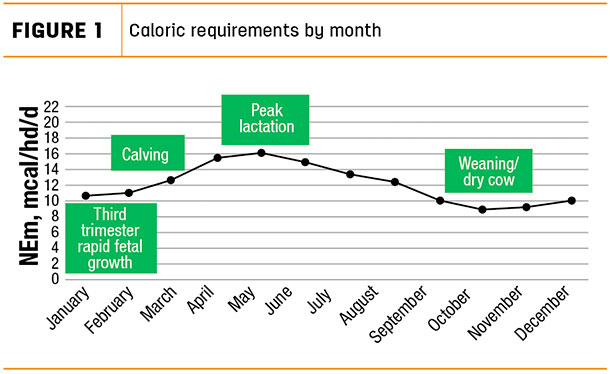It’s as easy as this: calories in versus calories out.
If your cattle consume more calories than they burn, they will gain weight. If your cattle burn more calories than they consume, they will lose weight. If calories consumed equal calories burned, your cattle will maintain their current weight.
But why does this matter?
Body condition score (BCS) is the single-most important metric we have for a cow over the course of its year. Cows with an appropriate BCS are cows that get bred earlier in the season, produce better colostrum and tend to be more productive animals. So anything we can do to monitor and adjust a cow’s BCS is a step in the right direction for productivity and profitability.
When you understand the relevance of caloric intake to BCS, it’s easy to see the value of calories to your operation. However, measuring caloric intake in cattle is not as black and white. Unlike many of the foods you and I buy and eat, you’re not going to find a standard calorie count labeled on your cattle feed.
The following will give you a basis for understanding when your cows’ caloric requirements are highest, where in its diet the cow typically gets its calories from and how to evaluate whether adjustments ought to be made. Collectively, this information can help you understand and incorporate proper caloric management in your nutritional program.
Your cows’ caloric requirements
Your cows’ nutritional requirements will change throughout the year based on where they are in the production cycle (see Figure 1).

Let’s start with the point when a cow’s nutritional – and caloric – requirements are lowest: the second trimester after weaning. As the cow moves from this phase into the third trimester, we can expect rapid fetal growth. This explosion in growth requires an increase in all nutrients and calories alike. Six weeks before calving, the cow is going to start building colostrum. When the cow calves and begins to lactate, this is where we’re going to see probably the single biggest jump in caloric needs annually.
Exactly how big will depend on the individual cow and the quantity and quality of milk it produces. Sixty to 70 days post-calving, a cow will hit peak lactation, which is the point of its highest nutritional and caloric requirements throughout the year. Following peak lactation, we start to experience a downward slope in the cow’s nutritional needs until it heads into the third trimester again.
We’ve already established the connection between caloric intake and BCS, but it’s important to note a skinny cow is not just a skinny cow, it’s an inefficient cow. In an industry in which efficiency is the name of the game, you really should consider the impact of underconditioned cows on their longevity and, ultimately, your financial stability.
Where do calories come from?
Overwhelmingly, your forage base should be the main source of calories for your cows. The most efficient thing we can do as producers is align the cow’s nutritional needs with its environment. This would imply when the cow’s caloric needs are highest in peak lactation, your best-quality forage is available. In this ideal scenario, the best use of dormant forage would be when the cow’s needs are lowest after weaning in the second trimester.
There are no absolutes in cow-calf production, but unless you have a compelling financial reason for your herd’s production calendar to be out of sync with the environment (i.e., club calf producer for calves marketed only at a specific time of year), you’re going to benefit by ensuring alignment.
In instances where your forage cannot provide the calories your cows need, higher-quality hay or energy-dense supplements might be an option for filling the deficit. Work with your local nutritionist or consultant from a reputable feed company to design the best program for your situation.
Evaluating the need for change
With BCS being the most effective measure for determining if your cows are getting the calories they need, frequency and consistency in reading BCS is critical. The most progressive cattlemen I work with are evaluating BCS on their herd at least monthly. This increases to every two weeks during critical stages of production such as pre-breeding.
Remember, BCS of 5 to 6 is the target range, and having too high of a BCS can have almost as many negatives as a low BCS. Most extension programs have BCS guides you can use to analyze your herd’s condition if you’re unfamiliar with the standards for each score.
If you see your cows often, it’s hard to see minor changes in BCS. I recommend you take pictures with your smartphone of multiple (five to 10 or so) cows that are easily identifiable. Every time you are planning to evaluate BCS (based on the frequency you establish), take new pictures of those same five to 10 cows and compare where they are on that day to the photos you last took of them. This will help you identify BCS changes without relying on memory alone.
With the photos handy, you can determine whether your cows’ BCS aligns with the needs of their current stage of production and adjust your feeding program accordingly.
Don’t forget:
- Calories in more than calories out = weight gain
- Calories out more than calories in = weight loss
- Calories in = calories out = weight maintenance
Let’s not overcomplicate the basics. ![]()
PHOTO: When you understand the relevance of caloric intake to BCS, it’s easy to see the value of calories to your operation. However, measuring caloric intake in cattle is not as black and white. Staff photo.

-
Dusty Abney
- Beef Technical Specialist
- Cargill Animal Nutrition
- Email Dusty Abney






